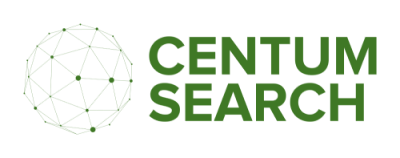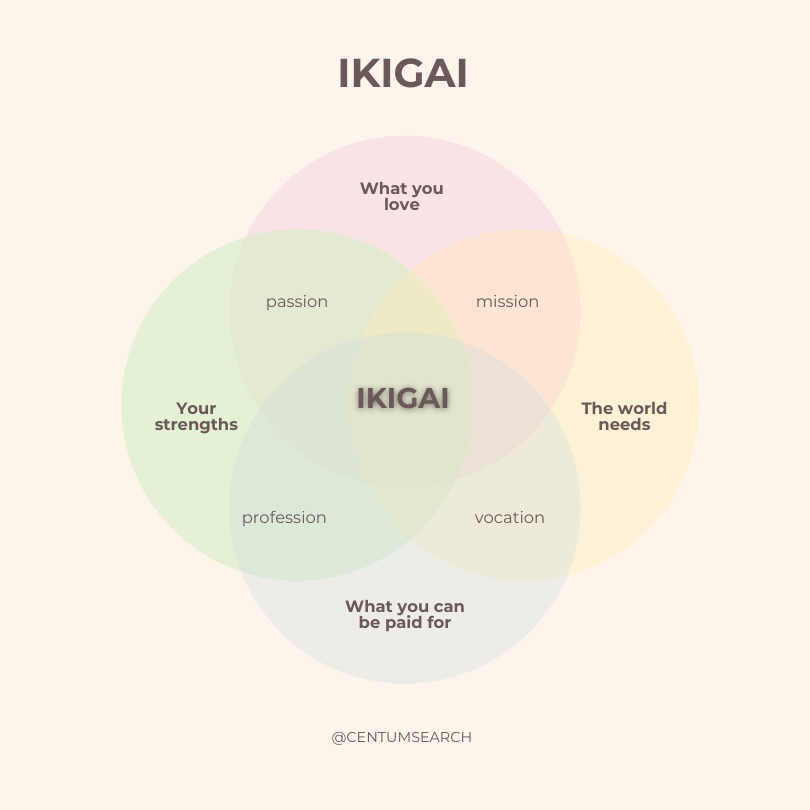How to Answer Behavioral Interview Questions with the SARR Method
Step-by-Step Guide to Mastering Behavioral Interviews with the SARR Method
(and software engineer response example)
Do you struggle to articulate your achievements during interviews? You’re not alone. Many job seekers find behavioral interviews challenging, especially when asked to recall specific situations on the spot. Behavioral interviews are designed to uncover how you’ve tackled real-world challenges in the past to predict your future performance. This interview method is almost always included in software engineering interview loops.
Instead of hypothetical scenarios, interviewers will ask you to “Tell me about a time…” or “Describe a situation where…,” focusing on how you’ve solved problems, made decisions, and achieved results.
Historically, the STAR method—Situation, Task, Action, Result—was the standard framework for structuring responses. It’s simple, clear, and effective at presenting your accomplishments. Even talent acquisition professionals and recruiters from Big Tech and top staffing agencies advise job seekers to use STAR to convey their experiences. However, STAR has a blind spot: it focuses on the “what” of your story but misses the “why” and “how” behind your growth.
That’s where the SARR method comes in. By replacing "Task" with "Reflection," SARR elevates your responses by highlighting the lessons learned and how you’ve applied them. This shift not only emphasizes your actions and results but also showcases your self-awareness, adaptability, and commitment to improvement—qualities hiring leaders value just as much as technical skills.
While STAR might help you share that you met a tight project deadline, SARR allows you to go further by reflecting on how you improved your time management skills and applied them to future challenges. The result? A deeper, more compelling narrative that positions you as a growth-oriented and results-driven candidate.
Let’s dive into how the
SARR method can help you stand out and leave a lasting impression in your next behavioral interview.
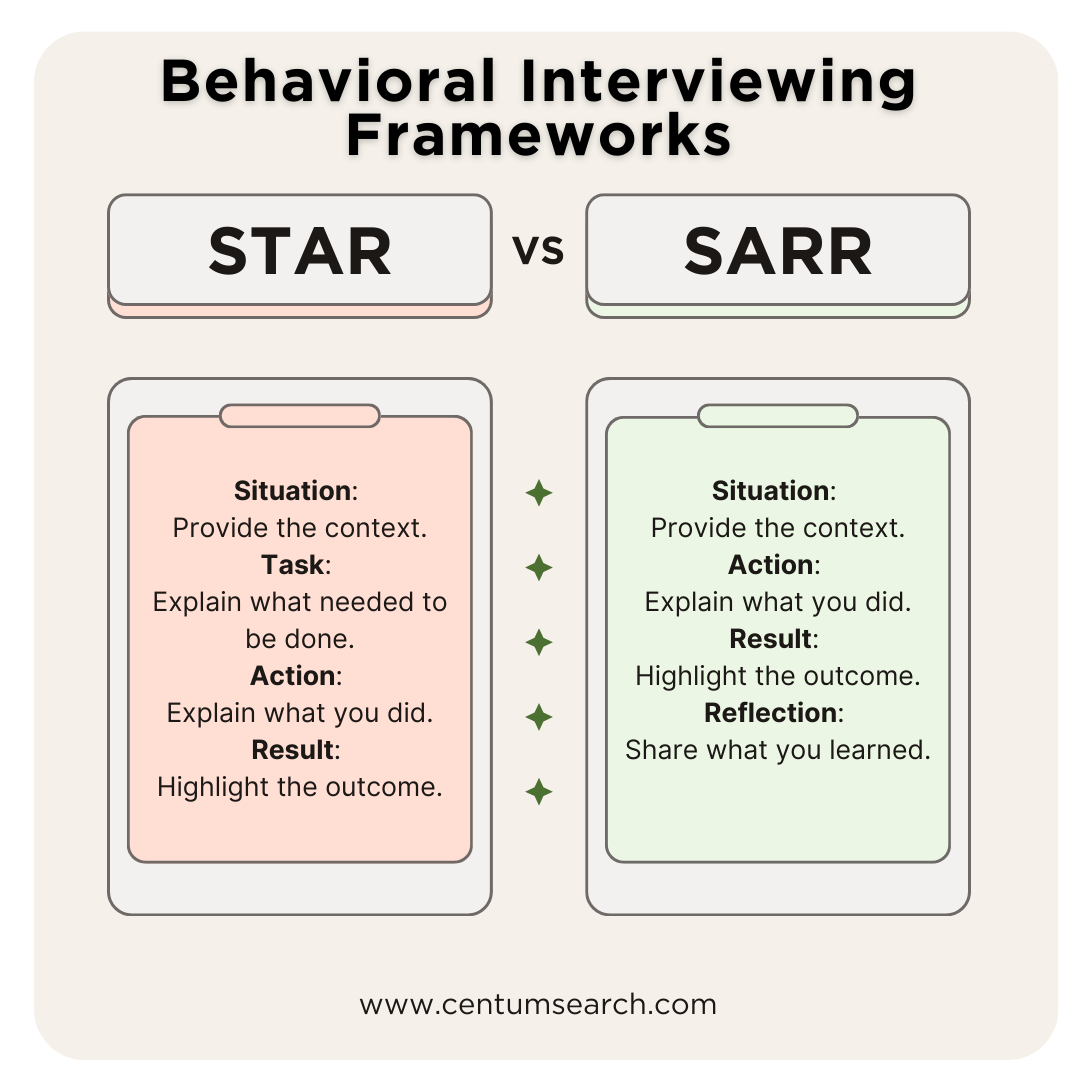
STAR Interview Method VS SARR Interview Method for Framing Behavioral Interview Responses
How to Approach Behavioral Interview Questions with the SARR Method
There are several frameworks you can use to structure your answers, but the SARR method—Situation, Action, Result, and Reflection—is one of the most effective. This method helps you craft organized, impactful responses that highlight your skills, accomplishments, and ability to grow. Adding a reflective component to your answers helps you stand out as a thoughtful and growth-oriented candidate.
With the SARR method, you’ll address the following:
- Situation: Provide the context.
- Action: Explain what you did.
- Result: Highlight the outcome.
- Reflection: Share what you learned.
By structuring your responses this way, you can clearly communicate your impact and demonstrate self-awareness, two traits hiring leaders value highly. Let’s break down each step of the SARR method so you can ace your next interview.
1. Situation: Set the Scene
Think of this step as setting up a story—you need to give enough background for your audience (the interviewer) to understand what was happening. The situation is the "where" and "when" of your story, and it’s your chance to explain the problem, challenge, or opportunity you were facing.
This doesn’t mean giving a novel-length answer! Instead, aim to strike a balance between being informative and concise. Provide just enough context for the interviewer to follow along without losing sight of the main point.
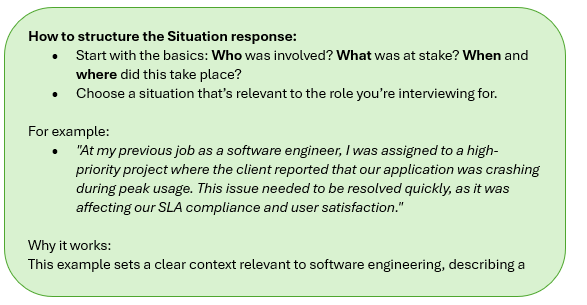
Why is this step important? Because without a clear context, your story will not land as effectively. A well-defined situation is like a strong opening line—it hooks your audience and sets the stage for everything else you’re going to share.
2. Action: Explain What You Did
Now that you’ve got the interviewer invested in your story, it’s time to shine a spotlight on you. The Action part is all about showing what you specifically did to address the situation.
This is where you demonstrate your problem-solving skills, creativity, and initiative. The interviewer wants to know what steps you took, why you chose those steps, and how your actions contributed to resolving the problem or achieving the goal.
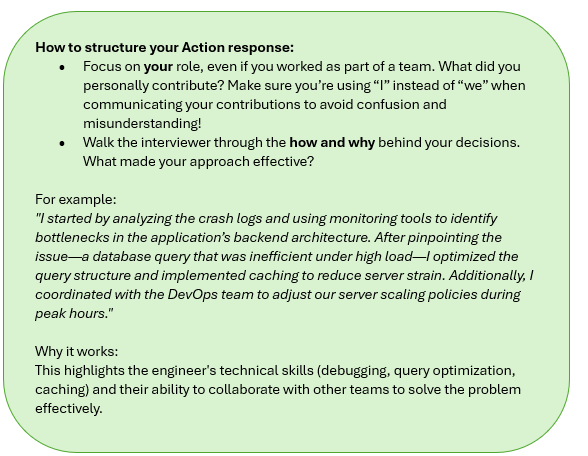
Here, you’re not just listing actions—you’re explaining your thought process. This gives the interviewer insight into your problem-solving approach, which is just as important as the actions themselves.
3. Result: Highlight the Outcome
Every great story needs a satisfying conclusion, and in an interview, the Result is where you get to show off your impact. This part is crucial because it demonstrates the tangible value of your actions.
Don’t shy away from numbers! Hiring leaders love measurable outcomes because they make your contributions more concrete and memorable. If you don’t have hard data, focus on the qualitative impact—what changed because of your efforts?

This step ties your story together, proving that your actions made a real difference. It’s also a great opportunity to highlight your ability to deliver results—a key trait every employer is looking for.
4. Reflection: What Did You Learn?
Here’s where the SARR method sets itself apart. Reflection adds a layer of depth to your answer by showing that you don’t just complete tasks—you grow and learn from your experiences.
By sharing what you learned, you demonstrate self-awareness and a commitment to continuous improvement. It’s also a chance to connect the story back to the role you’re applying for, showing how your past experiences have prepared you for future challenges.
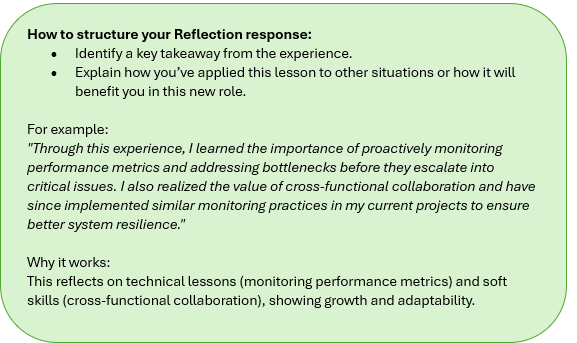
Reflection adds a personal touch to your answer and leaves the interviewer with the impression that you’re not just capable—you’re also thoughtful and adaptable.
By structuring your answers using the SARR method, you’ll have a clear, engaging, and memorable way to present your experiences. And the best part? This approach not only makes you more confident in your responses but also leaves hiring leaders with a strong sense of your value.
Behavioral interviews can feel challenging, but with the right strategy, they’re an incredible opportunity to showcase your skills, experience, and growth potential. The SARR method—Situation, Action, Result, and Reflection—offers a simple yet powerful framework to structure your responses in a way that’s clear, impactful, and memorable.
By setting the scene, highlighting your actions, quantifying your results, and reflecting on your growth, you’ll stand out as a candidate who not only delivers results but also learns and improves along the way. Remember, interviewers aren’t just looking for someone who can check the boxes—they’re looking for someone who can bring value, adapt to challenges, and grow with the team.
Take the time to prepare a few SARR-based answers before your next interview, focusing on experiences that align with the role you’re applying for. With practice, you’ll feel more confident and ready to tackle even the toughest behavioral questions.
Your next big opportunity is just one well-structured answer away. Go into your interviews with the SARR method in hand, and let your story do the talking!
If you found this helpful, subscribe to our newsletter for more resources!
Subscribe to our newsletter!
We will get back to you as soon as possible.
Please try again later.
Resources for Careers, Talent Acquisition and Management

a b c d e f g h i j k l m n o - Do not remove from template!!! it is important to support different fonts
Questions?
Contact Us
Thank you for contacting us!
We will get back to you as soon as possible!
Oops, there was an error sending your message.
Please try again later.
